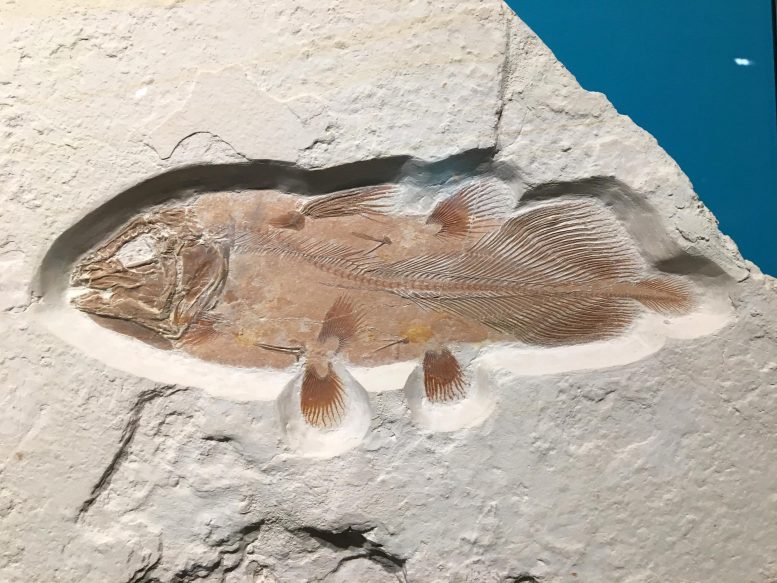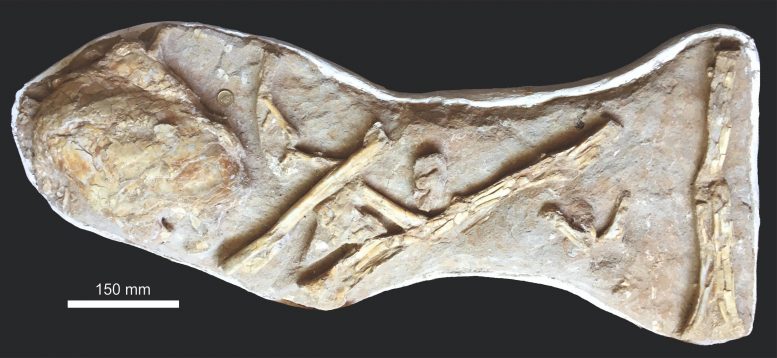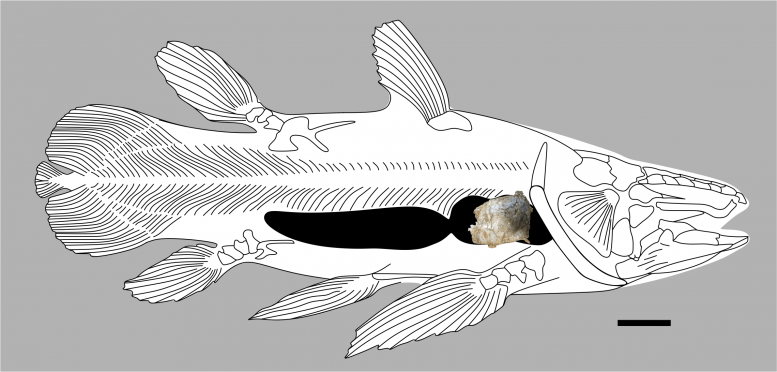
An example of what a complete fish fossil coelacanth looks like. This one is from the Jurassic of German. Credit: Professor David Martill, University of Portsmouth
A serendipitous discovery of a fossilized bony lung reveals a massive ancient fish.
Fossilized remains of a fish that grew as big as a great white shark and the largest of its type ever found have been discovered by accident.
The new discovery by scientists from the University of Portsmouth is a species of the so-called ‘living fossil’ coelacanths that still swim in the seas, surviving the extinction that killed off the dinosaurs.
The discovery was purely serendipitous. Professor David Martill, a paleontologist from the University’s School of the Environment, Geography and Geosciences, had been asked to identify a large bone in a private collection in London.
The collector had bought the specimen thinking the bone might have been part of a pterodactyls’ skull. Professor Martill was surprised to find it was not in fact a single bone, but composed of many thin bony plates.

The original slab, as purchased, with the coelacanth ossified lung in close proximity to a series of associated, but disarticulated wing elements of a large, but indeterminate pterosaur. Credit: University of Portsmouth
He said: “The thin bony plates were arranged like a barrel, but with the staves going round instead of from top to bottom. Only one animal has such a structure and that is the coelacanth — we’d found a bony lung of this remarkable and bizarre-looking fish.
“The collector was mightily disappointed he didn’t have a pterosaur skull, but my colleagues and I were thrilled as no coelacanth has ever been found in the phosphate deposits of Morocco, and this example was absolutely massive!”
Professor Martill teamed up with leading Brazilian paleontologist Dr. Paulo Brito, of the State University of Rio de Janeiro, to identify the fossil. Dr Brito has studied coelacanths for more than 20 years and is an expert on their lungs, and was astonished at the size of this new specimen.
The fossil had been embedded in a block of phosphate, backed with plaster and covered in a coating of lacquer, which had caused the bones to turn brown. It was found next to a pterodactyl which proves it lived in the Cretaceous era – 66 million years ago.

The specimen of the coelacanth lung and its likely position as the anterior chamber in a mawsoniid coelacanth.
Credit: University of Portsmouth
The private owner offered to cut the remains of the bony lung off the slab and give it to the team for free. They then had to remove the coating and further expose the bones using specialist equipment, including dental tools and fine brushes.
Professor Martill and colleagues were able to determine they’d found a surprisingly large coelacanth because of the abnormal size of the lung. They calculated it may have been five meters in length – substantially larger than the rare and threatened modern-day coelacanths, which only grow to a maximum length of two meters.
He said: “We only had a single, albeit massive lung so our conclusions required some quite complex calculations. It was astonishing to deduce that this particular fish was enormous – quite a bit longer than the length of a stand-up paddleboard and likely the largest coelacanth ever discovered.”
Coelacanth fishes first appeared (evolved) 400 million years ago – 200 million years before the first dinosaurs. It had long been believed to be extinct, but in 1938 a living coelacanth was found off South Africa.
The fossil is now being returned to Morocco where it will be added to the collections in the Department of Geology at Hassan II University of Casablanca.
The research is published in Cretaceous Research.
Reference: “A marine Late Cretaceous (Maastrichtian) coelacanth from North Africa” by Paulo M. Brito, David M. Martill, Ian Eaves, Roy E. Smith and Samuel L. A. Cooper, 23 January 2021, Cretaceous Research.
DOI: 10.1016/j.cretres.2021.104768
March 04, 2021 at 05:44AM
https://ift.tt/3bXQZ5z
Enormous Ancient Fish Discovered by Accident – Bizarre-Looking and “Absolutely Massive!” - SciTechDaily
https://ift.tt/35JkYuc
Fish
Same as modern day Coelcanth. Only larger species, which is to be expected. No evidence of any changes by evolution in 400 million years? Yet this is supposed to have hopped out the water onto land and grew legs? No chance.
ReplyDelete